The big MTB headline today: RockShox finally dropped its Flight Attendant system for its XC-focused SID suspension line.
Flight Attendant is an electronic system that controls your suspension automatically by opening and locking it on the fly. It reacts instantly to the terrain (and your pedaling effort, but more on that in a bit). So instead of reaching for a manual lockout on your shock or bars, you can simply focus on riding.

This Flight Attendant-equipped Trek Slash 9.9 sold in minutes last month.
Flight Attendant is nothing new. It first appeared in 2022 in the trail and enduro world, attached to the RockShox Zeb, Lyrik, and Pike forks and the Super Deluxe rear shock.
 We've seen A LOT of Pivot Mach 4s running Fox Live Valve.
We've seen A LOT of Pivot Mach 4s running Fox Live Valve.
Electronically controlled suspension systems are nothing new either. FOX introduced its Live Valve system way back in 2018. It was updated to Live Valve 1.5 last year, and many are anticipating a completely new (probably wireless) Live Valve 2.0 system sometime this year.
A couple of years ago, I also posted about electronically controlled MTB suspension being one of the big future tech trends, and it seems like that (admittedly safe) prediction coming to fruition. Am I happy about that? Maybe.
The tech and ride improvements of Flight Attendant and its future competitors are exciting to me. Yet part of me dreads the day I end up owning a bike with 7 — yes, 7! — batteries on it. The electronic overlords have truly come to take over XC racing.
[button]Shop Mountain Bikes[/button]
Welcome to Battery-mageddon
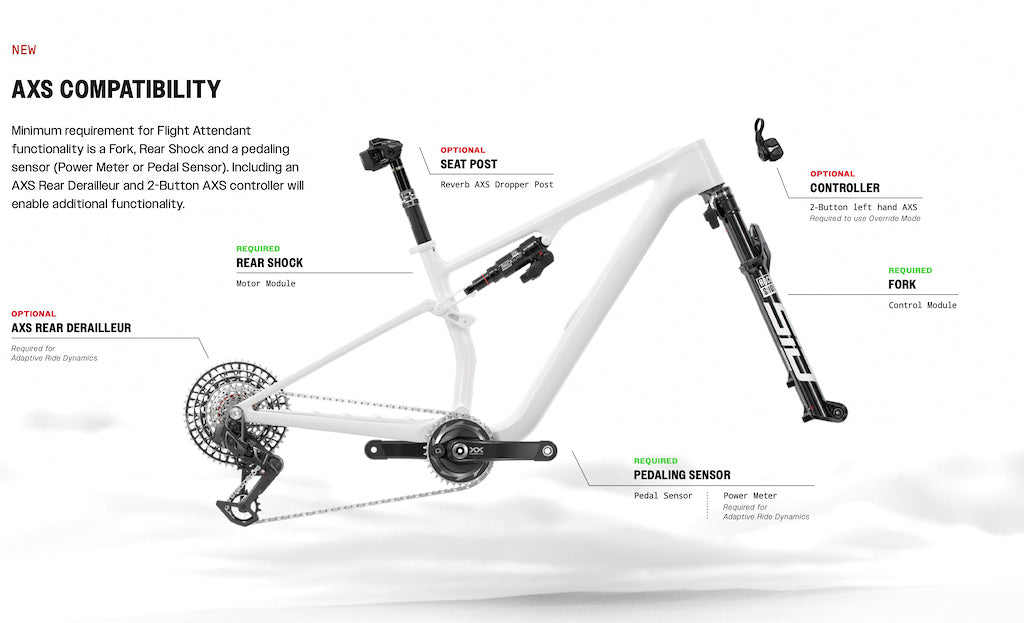 Yo, Dawg, I heard you like batteries...
Yo, Dawg, I heard you like batteries...
First off, let me tell you how I counted up 7 batteries. Flight Attendant is part of SRAM’s AXS wireless electronic ecosystem. To use it, at a bare minimum you need Flight Attendant controllers on the front fork and rear shock, plus a SRAM/Quarq power meter or axle-based pedal sensor. That’s 3 batteries right there — 2 AXS batteries plus the small coin cell battery in the power meter of pedal sensor.
If I’m rocking a Flight Attendant-equipped mountain bike, then I’ve probably also maxed out my credit card to get a bike with a full SRAM T-Type Transmission drivetrain. Add 2 batteries for that — 1 AXS battery in the rear derailleur and a coin cell in the AXS controller/shifter.
If I'm going full AXS, then I'll have to run a wireless AXS Reverb dropper post too. That adds another AXS battery and coin cell. Boom, now you’ve got a bike with 7 batteries — 4 of which are AXS batteries that will need regular recharging.
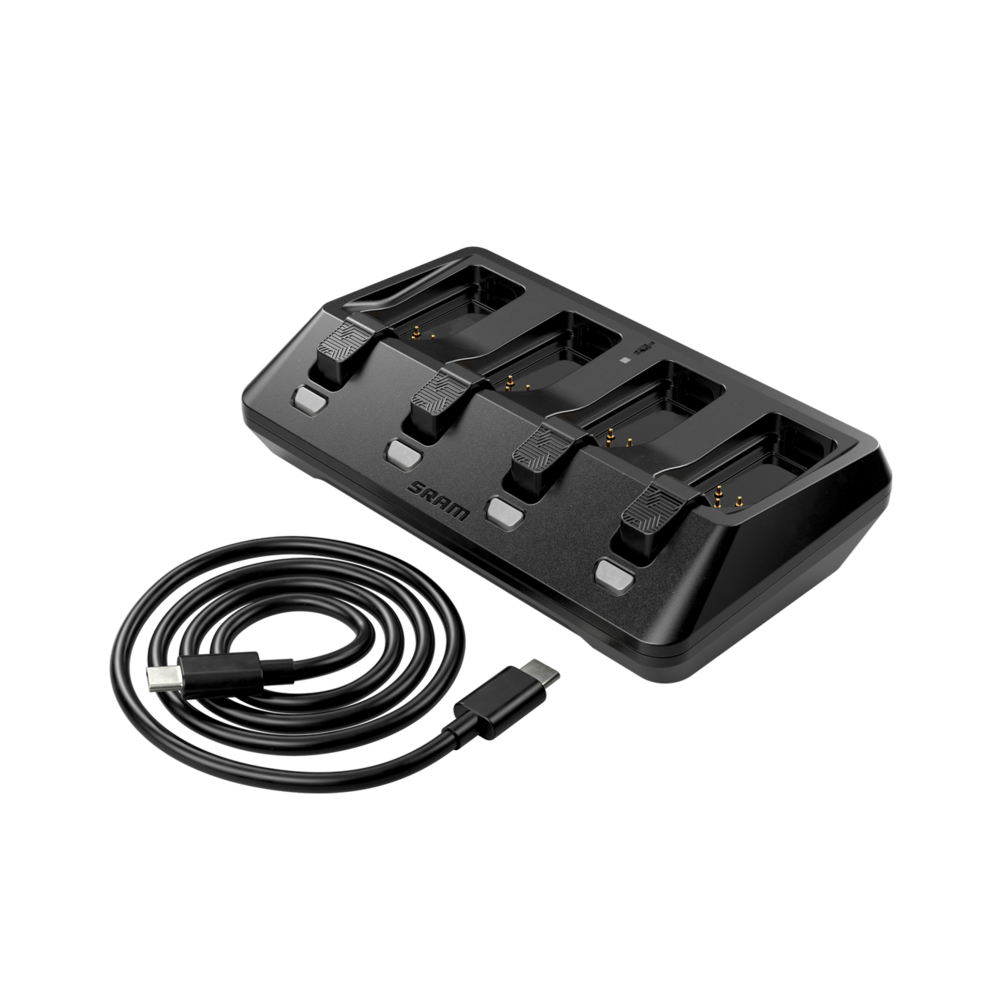 Perhaps they designed the charger first, and then made Flight Attendant as an excuse to use it...
Perhaps they designed the charger first, and then made Flight Attendant as an excuse to use it...
But guess what!? SRAM makes a “Four Battery Charger” so you can charge all 4 at the same time. Clever girl. They planned this from the beginning!
[newsletter]
What Do All Those Extra Batteries Do?
 Nino broke the World Cup win record last year on Flight Attendant. The only difference between him and me is our suspension tech... at least that's what I tell myself... Photo: Bartek Wolinski / Red Bull Content Pool
Nino broke the World Cup win record last year on Flight Attendant. The only difference between him and me is our suspension tech... at least that's what I tell myself... Photo: Bartek Wolinski / Red Bull Content Pool
Many pros were already racing on Flight Attendant last season, including the legendary Nino Schurter, the undisputed G.O.A.T. of XC mountain bike racing. He used Flight Attendant to achieve his ninth World Cup overall win. SRAM even quoted him in its marketing materials:
IT’S F*CKING NEXT LEVEL - Nino Schurter
That’s a pretty ringing endorsement. For a rider like Nino, a system like Flight Attendant makes a lot of sense. XC racers use remote lockouts more than most mountain bike riders to maximize efficiency on flat sections and climbs.
 During a 90-minute World Cup race, Nino will activate his remote lockout over 300 times. The physical motion of activating a little bar-mounted lockout remote doesn’t sound like a big deal, but every time you do it expends a bit of mental energy. At the sharp end of the sport, that small bit of extra thought and effort matters, especially when you have to make these decisions while absolutely pinned during a race.
During a 90-minute World Cup race, Nino will activate his remote lockout over 300 times. The physical motion of activating a little bar-mounted lockout remote doesn’t sound like a big deal, but every time you do it expends a bit of mental energy. At the sharp end of the sport, that small bit of extra thought and effort matters, especially when you have to make these decisions while absolutely pinned during a race.
Flight Attendant makes the suspension lockout automatic so riders like Nino can focus their full attention on riding. Furthermore, it is so fast, that it can actually do A LOT more than Nino's 300+ lockouts. When Nino won his record-breaking 34th World Cup race last year, his Flight Attendant made 1,325 suspension changes in just under 90 minutes.
 It’s able to firm up the suspension in instances where the rider can’t (or won’t) do it manually due to time, energy, or other factors. Imagine pedaling across a trail that is quickly alternating between smooth and choppy sections.
It’s able to firm up the suspension in instances where the rider can’t (or won’t) do it manually due to time, energy, or other factors. Imagine pedaling across a trail that is quickly alternating between smooth and choppy sections.
With a manual remote, it might be too much of a hassle to keep switching between locked and open modes, so most riders will just leave it in one mode or the other. Flight Attendant, however, can change back and forth instantly and seamlessly, maximizing your speed and efficiency on this sort of terrain.
Not only that, the latest Flight Attendant is built on the proven RockShox Charger 2 Race Day damper which provides 3 compression modes — Open, Pedal, and Closed/Locked. Previously, RockShox’s XC race dampers only provided open and locked modes. This means it can now also choose a middle “Pedal” option for certain situations to optimize the balance between efficiency and comfort.
SRAM claims that using Flight Attendant can increase a rider’s average speed by 1.8% when compared to those same riders using a manual system. That sounds small but over a 90 minute XC race, that’s 96 seconds. For the world’s best racers, that could be the difference between winning and finishing outside the top 10.
Controlled by the Algorithm
 It's got some brains hiding in there.
It's got some brains hiding in there.
As I said, we’ve seen this sort of tech before in Fox’s Live Valve system. You could even argue that Specialized’s longstanding Brain suspension system has been doing the same thing for over a decade, only without electronics.
Brain uses an inertia valve that remains closed to support the suspension under pedaling forces, but it can open when it senses a bump, delivering efficiency and compliance when needed.
The big advantage of an electronic system, however, is greater speed and intelligence. The big goal of the latest Flight Attendant release is to take that intelligence to the next level using “Adaptive Ride Dynamics.”
Adaptive Ride Dynamics is an algorithm that helps Flight Attendant make better decisions. It gathers this data while you ride and learns from it to increase precision and accuracy. The data largely comes from your power meter (meaning you’ll need a compatible SRAM/Quarq power meter to take advantage of Adaptive Ride Dynamics).
 It essentially splits your riding/pedaling into 4 “effort zones” — Sprint, High Effort, Medium Effort, and Low Effort — based on how much power you’re putting out. You can set the power range for each zone in the SRAM AXS app, or you can let Adaptive Ride Dynamics set it for you automatically by studying your riding habits.
It essentially splits your riding/pedaling into 4 “effort zones” — Sprint, High Effort, Medium Effort, and Low Effort — based on how much power you’re putting out. You can set the power range for each zone in the SRAM AXS app, or you can let Adaptive Ride Dynamics set it for you automatically by studying your riding habits.
Here’s how Flight Attendant uses Adaptive Ride Dynamics to adjust itself based on which zone you’re riding in:
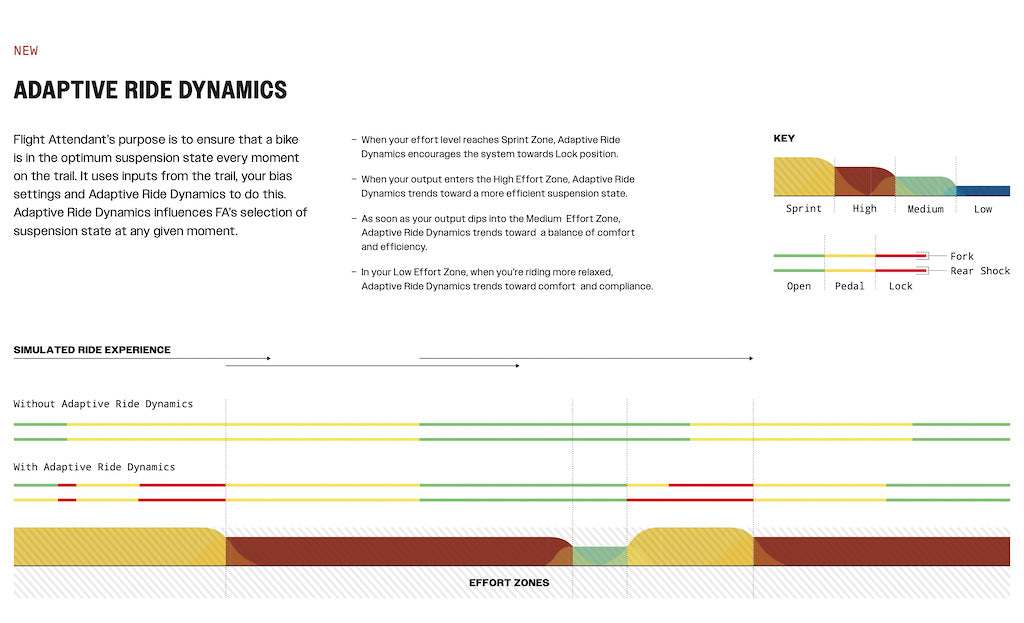
- Sprint Zone: Adaptive Ride Dynamics encourages the system towards a locked-out position.
- High Effort Zone: Adaptive Ride Dynamics trends toward a more efficient suspension state (Locked or Pedal mode).
- Medium Effort Zone: Adaptive Ride Dynamics trends toward a balance of comfort and efficiency (Pedal or Open mode).
- Low Effort Zone: Adaptive Ride Dynamics trends toward comfort and compliance (Open mode).
 Do you favor descending performance? You can adjust for it.
Do you favor descending performance? You can adjust for it.
There’s also another smart feature called “Bias Adjust” which gives you the ability to fine-tune how Flight Attendant reacts. You can use Bias Adjust to instruct the Flight Attendant system to favor more Open or more Locked suspension positions to better match your riding style and terrain.
It also allows for “split states.” Unlike Fox’s Live Valve or most current cable-actuated lockout systems, the Flight Attendant can put the fork and rear shock in different suspension positions to, again, match your riding style and terrain.
If you’re like me, you may like having the shock locked and the fork open for a nice combo of pedaling efficiency and hand comfort. You can have that. It’s all tuneable in the AXS app, or the system can figure it out just based on how you ride.
How Much is Flight Attendant Going to Cost?
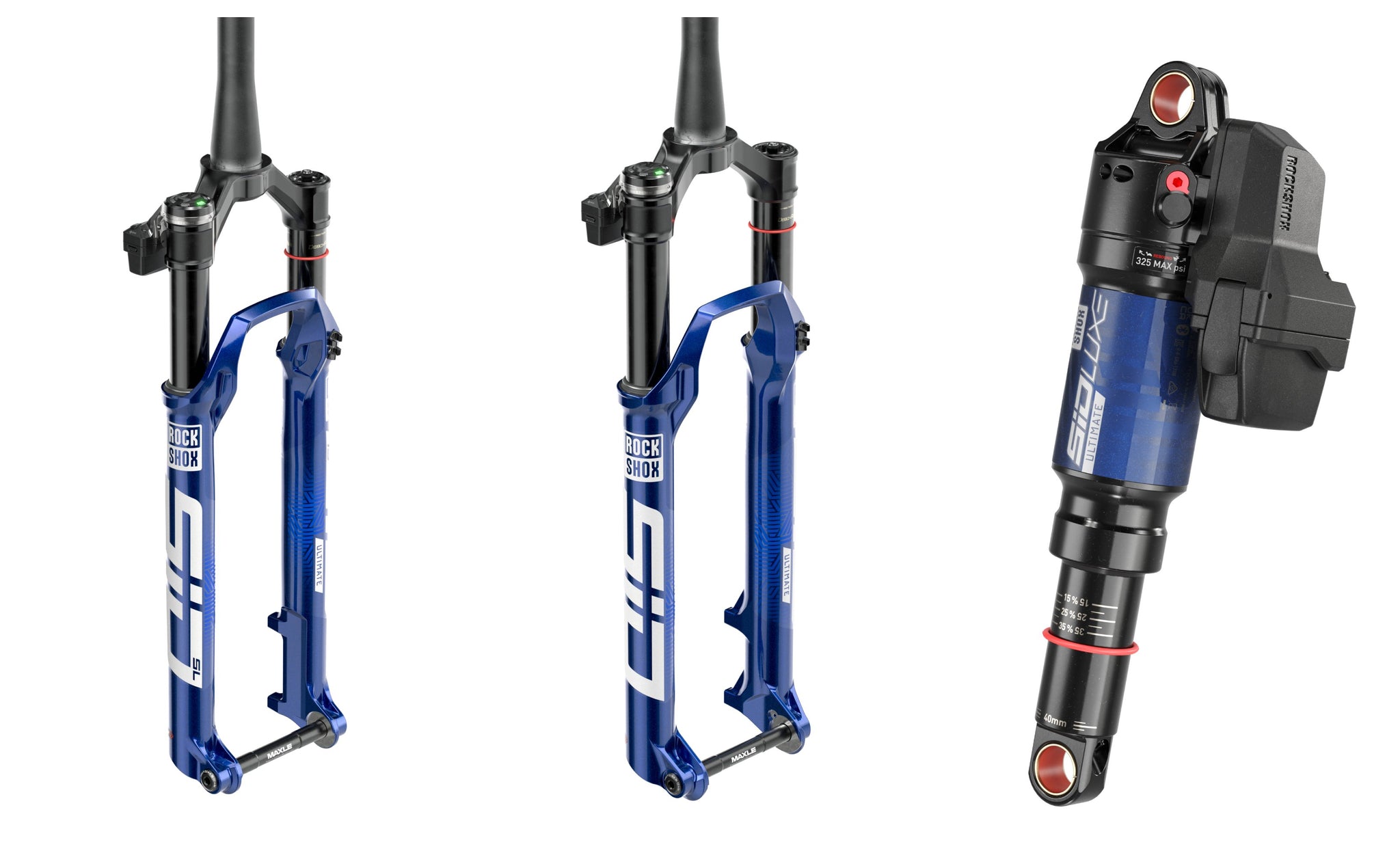 It should probably come as no surprise, but it’s fairly pricey.
It should probably come as no surprise, but it’s fairly pricey.
A Flight Attendant-equipped SID SL Ultimate 100mm fork is $1,349, while the slightly beefier SID Ultimate 120mm fork will be $1,449. The Flight Attendant SIDLuxe shock will be $849. That’s $2,200-2,300 in just the suspension components.
To use the suspension, you’ll at least need a pedaling sensor, which SRAM lists at $14-122, but I actually haven’t even seen one for sale. They seem to only come on trail/enduro bikes that come with Flight Attendant.
Likely, most XC racers will want to use a SRAM/Quarq power meter to have power readings and to use Adaptive Ride Dynamics. SRAM’s current MTB power meter models range from $326-643 IF you already have a SRAM crank and are just buying the power meter seperately.
You’re looking at $2,500-3,000 to get Flight Attendant running on your XC bike, and that’s only if it fits your bike. SRAM has confirmed fitment for several bikes:
- 2023+ Canyon Lux Trail / Lux World Cup
- 2023+ Mondraker F Podium
- 2020+ Orbea Oiz / Oiz TR
- 2023+ Pivot Mach 4 SL V3
- 2022+ Santa Cruz Blur / Blur TR
- 2020+ Specialized Epic Evo
- 2024+ Specialized Epic
It will fit more bikes, but it’s not confirmed yet. (It should fit the 2022+ Scott Spark since Nino ran it, right?) If you can justify buying a whole new bike just to use it, then cost likely isn’t a concern for you.
Does It Add Weight?
Brace yourselves, weight weenies, Flight Attendant will add some weight. Here’s what the SRAM rep said: “The system adds around 220 grams for XC components and 308 grams for Trail/All Mtn/Enduro components.”
Really, it’s not that much extra weight, and for racing applications, the efficiency gains likely outweigh the extra grams.
So Is It Worth It?
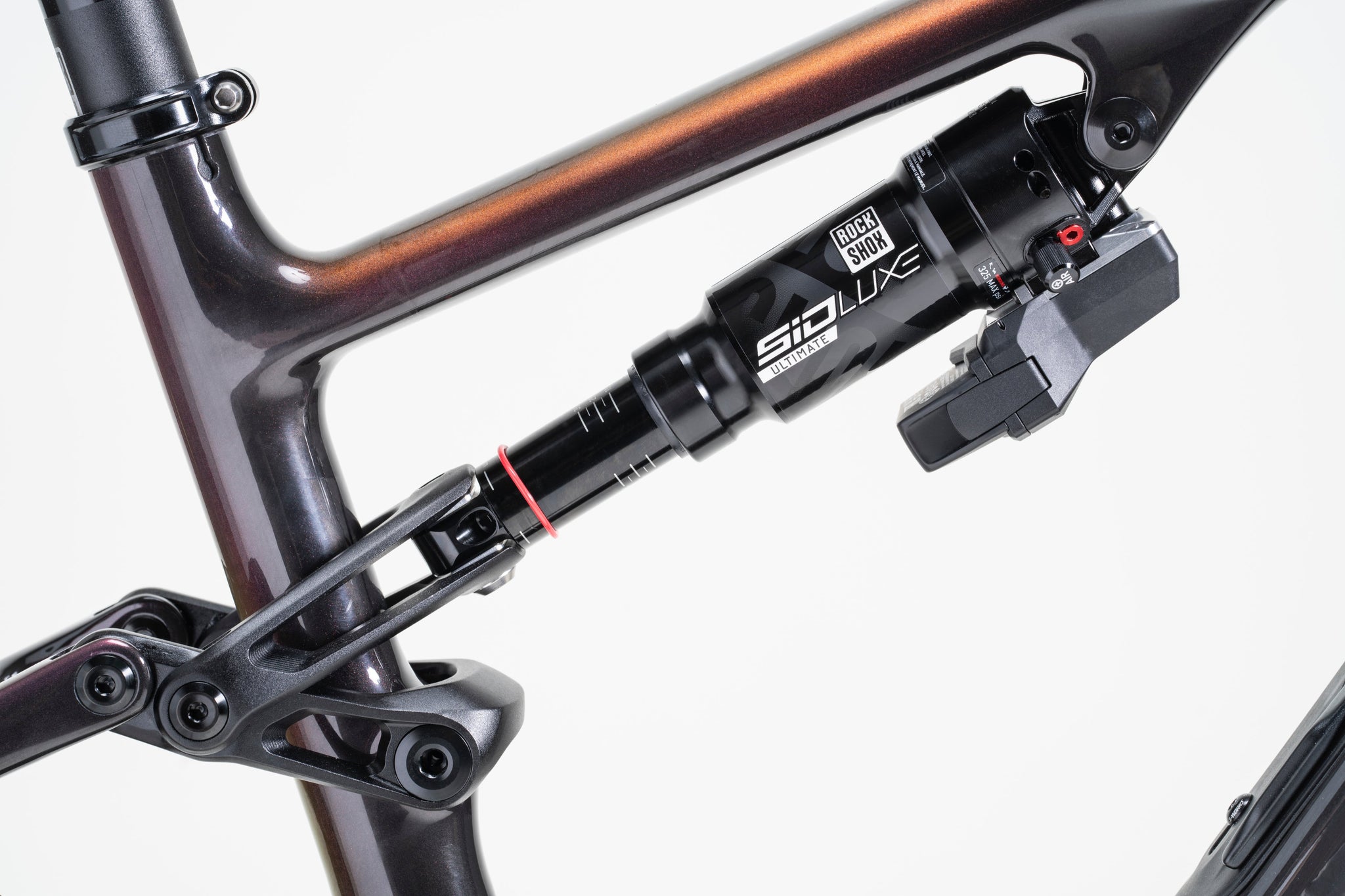 For the world’s best XC racers? Yes, definitely. Winning at the highest level is all about marginal gains and any system that allows a racer to devote more mental and physical energy to pedaling, handling, and racing will give them an advantage.
For the world’s best XC racers? Yes, definitely. Winning at the highest level is all about marginal gains and any system that allows a racer to devote more mental and physical energy to pedaling, handling, and racing will give them an advantage.
For normies like me, though, probably not. It’s incredibly cool, and I want it, but it’s WAY too expensive for me right now. It also definitely won’t improve my regular mid-pack finishes.
It’s also just way too complicated for me to deal with right now. I currently own 4 bikes equipped with AXS drivetrains. You’d think after a few years I’d be good at keeping all my derailleur batteries charged, but no, I suck. This year I’ve already run out of juice in the middle of a ride.
I don’t plan on making that mistake again, so I’m being good about taking my batteries off every few rides and popping them on the charger. It's annoying, so adding two more batteries into the mix just doesn’t appeal to me (yet).
Really, any rider already against adding more electronics to bikes probably won't be into this, even if it does provide a performance advantage. There is something to be said about the simplicity of a bike that never needs charging.
Maybe when my life is less chaotic (and I’m more wealthy), then I can justify owning it. On that note, I have a bet to make. I’m doing the Leadville Trail 100 MTB this year. Last year, my co-worker Craig built up a brand new Specialized S-Works Epic Evo with the latest SRAM T-Type Transmission. It was a crazy expensive build, but Craig said when he lined up at the start, all the amateur racers around him seemed to be running the same set-up.
When I line up at Leadville this year, I bet you I’m going to see a shocking amount of amateur racers (likely all middle-aged men) running the new Flight Attendant. For big events, a lot of people seem willing to fork out the dough.
Bonus: My Flight Attendant Wish List
 Could I do this all from a remote?
Could I do this all from a remote?
I want to cap off this post with a few things I think we could see on Flight Attendant in the future:
- AXS Remote Compatibility - Flight Attendant has a manual or override mode, but you control this from the fork crown or the AXS app. Could this be toggled using the current AXS bar-mounted controller? If you use the controller on the left side, only one button is needed if you have it paired with an AXS Reverb dropper. Why not use the other as a manual lockout? I’m sure some riders would love to have an instantaneous/effortless lockout that they can control manually.
- Different AXS Battery Sizes - This is more of a request for the entire SRAM AXS line-up. So far, everything uses the same standard battery. This is convenient, but part of me would love both a lightweight “SL” version specifically for racing and maybe a bigger heavy-duty “HD” version with more battery life for super long-distance adventures (or lazy chargers like me).
- A Flight Attendant Dropper - Can I use Flight Attendant trained with Adaptive Ride Dynamics to raise and lower my AXS Reverb dropper post for me? No, wait. Actually, scratch that, this is a terrible idea… Don’t do it, SRAM! (I bet you some goofy SRAM engineer has already thought of this and is trying it.)
[button]Shop Mountain Bikes[/button]

























